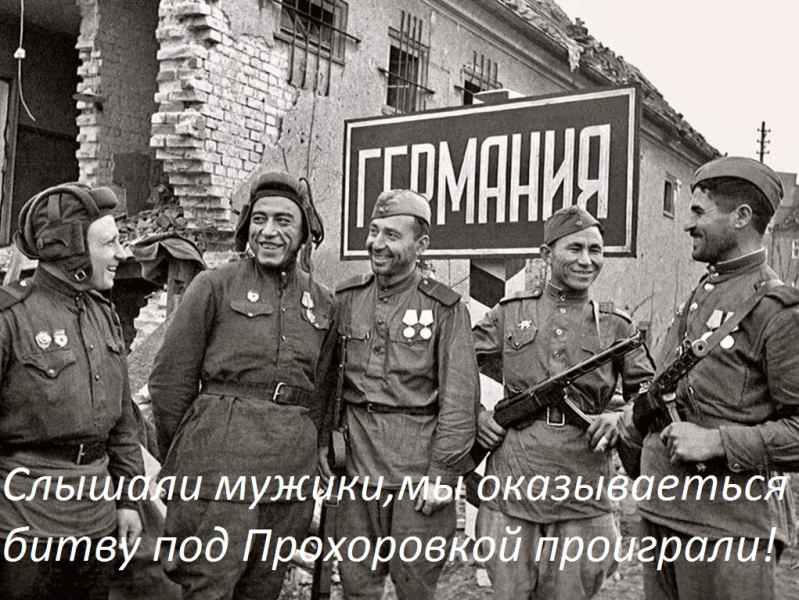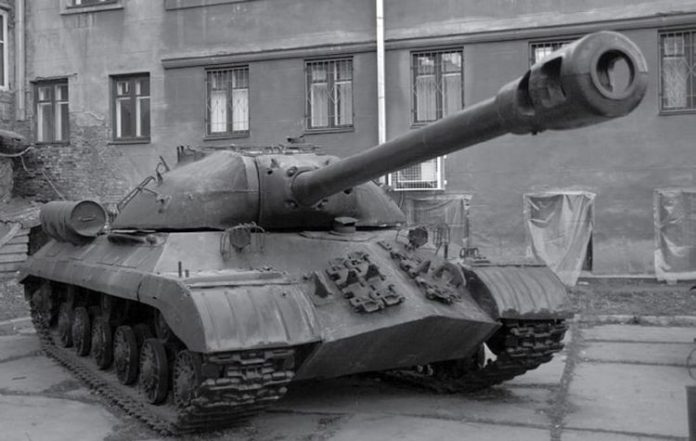
The overall layout thin IS-3 was traditional - the main part of the tank was a tower and enclosure with chassis. The hull and turret housed mechanisms and components, necessary for the normal operation of a tank, as well as space for the crew.
Inside the body of the tank was divided metal partition on a combat unit with control station and separation force. control station is the location of the driver, which was located on the longitudinal axis of the machine. Above him there was a triangular hatch with a sliding lid to the side, located on the roof of the hull before the tower. The manhole cover was mounted viewing device, providing a driver-mechanic external review. it had to be removed before opening the hatch. Near the seat of the driver are the tank controls and instrumentation. And behind him in the bottom of the tank was located escape hatch, here also kept stores of ammunition for the machine gun.
In the middle of the hull (for control and in the turret compartment) were fighting compartment. In the fighting compartment placed: seat loader, gun commander and commander of the tank, the main part of the ammunition and spare parts. The metal wall between the combat compartment and force had several hatches and the openings, facilitate access to the motor assemblies.
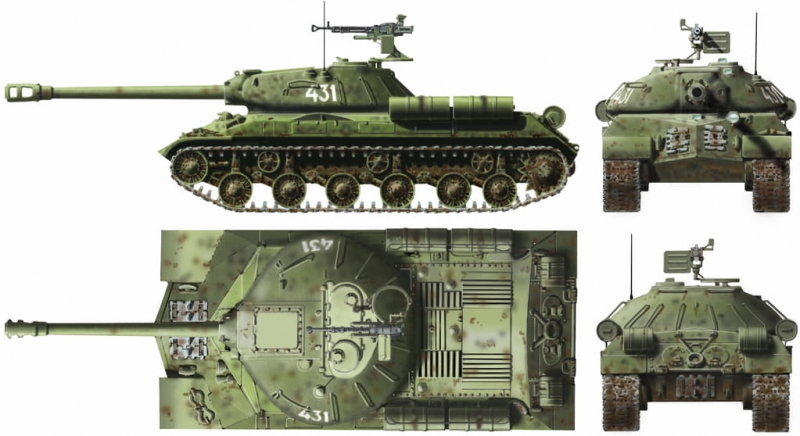 Tank IS-3: general view from different angles
Tank IS-3: general view from different angles
Cast tower had flattened spherical shape. The roof of the tower was a large oval hatch, closed by two covers. The right cover is viewing device loader (MK-4), and the left - the commander's hatch was located observation, closed circular rotating lid, which it was installed commander of the observation unit (MK-4 with a button control turret rotation). This device is intended to monitor the terrain, determining the target range, for targeting and adjusting artillery fire. Developed the commander's turret IS-3 did not have. This design solution difficult to explain, since all the Soviet tanks already had commander's cupola to the IS-3 design time, the need for a commander of a meaningful observation of the battlefield has become recognized. practice shows, that its absence can not make even the most successful in design periscopes Omnidirection.
The mask cast turret was installed tank 122-mm cannon and coaxial 7.62-mm machine gun DT. In addition to guns, ammunition was stored in the tower (ammunition) and there was a radio station, which he served as a tank commander. The shells were placed in the tower in special trays (25 shells). On the right side of the gun and was laying on five cartridges. Maximum turret rotation rate was 12 ° / a. turn electric actuator was equipped with a commander's control system: commander could, keeping the goal in sight of his vision devices, press the button and rotate the tower in a predetermined direction along the shortest path. When the sight line coincidence with the barrel axis tower stopped. Elevation cannon to aim the gunner carried out by a manual mechanism.
weaponry
Main tank armament was 122mm gun D-25T sample 1943 of the year, with a barrel 48 calibres. The gun was equipped with a two-chamber muzzle brake and horizontal wedge gate with semi-automatic mechanical type. Practical rate was 2-3 shots per minute, a range of direct-fire rounds - 1100 m. Gun ammunition consisted of 28 rounds of separate loading: 18 high-explosive and 10 armor.
To facilitate the work of laying the loader, designed to accommodate piercing shells, dyed black, and the rest - in steel gray. For the gun used separate loading ammunition (high-explosive OF471 and PF-471N, armor-piercing B-471, BR-471 and BR-471B). projectile mass - 25 kg, starting speed - 781 m / s. From a distance 1000 meters directs armor piercing shell thickness 150 mm.
For combating air targets installed on the roof of the tower a heavy 12.7mm DShK sample gun 1938 year or DShKM sample gun 1938/1944 of the year (Degtyareva and Shpagin design). The fire from the gun was conducted using the collimator sight K8-T, providing management aimed fire at targets, We are moving at a speed of 400 km / h at an altitude of 400 m. Ammunition to the machine gun was 250 rounds.
Chassis
The separation force was installed in a diesel-11-EC-3, together with auxiliary devices (lubrication system, Power and cooling). Engine B-11 EC-3 is a four-stroke diesel dvenadtsatitsilindrovy liquid cooling maximum capacity 520 HP. and was, in fact, improved engine V-2K.
The engine compartment is equipped with four main fuel tank box-shaped: two tanks on the left of the engine and two - on the right (the left and right groups), total capacity of which was 450 l.
At the stern was attached four additional fuel tanks of cylindrical form, included in the power supply system. The capacity of each tank was 90 l. Additional fuel tanks made it difficult to turn the tower, so the crew could lose them if necessary, without leaving the car.
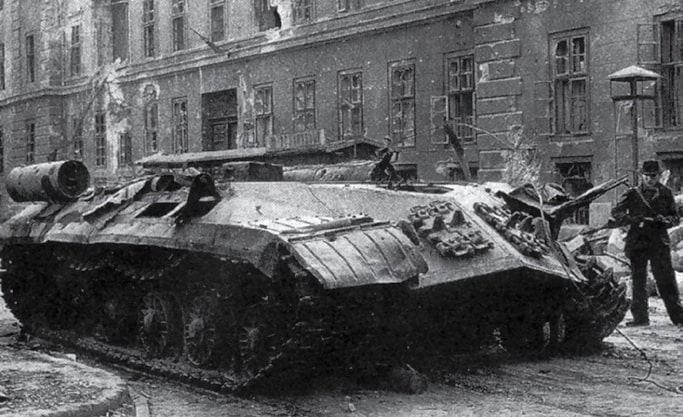 Lined the streets of Budapest, IS-3: as a result of the explosion of ammunition from a tank Towers
Lined the streets of Budapest, IS-3: as a result of the explosion of ammunition from a tank Towers
but, despite its fearsome appearance, at the very beginning of operation of the troops in IS-3 was showed a number of shortcomings, which were the result of structural failures and errors, committed in the course of its design. As the saying goes, "Too many cooks spoil the broth" - the fruit of joint creativity of designers and experienced CHKZ №100 factory has confirmed this proverb. for example, hasty design of the main part of the tank - armored housing IS-3 - has led to, his design, providing a very high level of snaryadostoykosti, It did not possess the required operational stiffness.
As a result, already in 1946 year had to create a commission to analyze the IS-3 defects. These included damage to the shell in the area of the engine compartment, gearbox failure, of the drive motor, etc.. Work on the organization of repair numerous parks IS-3 tanks was difficult and laborious. I had to re-develop the documentation for dismantling tanks, for measurement and inspection of basic units and parts, removed from vehicles, rejection of failed or proved to be useless because of design mistakes, and then work out the documentation on their restoration or repair. At the same time it was necessary to develop the documentation and activities, providing for the elimination of identified deficiencies during operation, take into account the remarks of the customer, while ensuring minimum labor input.
The complex of these special works for the elimination of technical defects, admitted designers, officially called MCI-703 (elimination of technical deficiencies in the facility 703). This task was entrusted of Leningrad - the designers of the Kirov factory. In almost all the departments EDTB Kirov plant were involved. Coordinated their experienced design engineer VA. Kozlowski. By the end 1951 it became possible to prepare a large amount of engineering documentation and release more 120 multipage instructions to restore the basic units of IS-3 tank.
As a result, MCI EC-3 was amplified turret plate and engine mount brackets, which improved body rigidity. A significant improvement has undergone transmission - the design of the main clutch has been improved, improved seal final drive, changed the gearbox mount. This helped to eliminate misalignment arising engine and transmission elements. Instead of manually installed electric pump maslopodkachivayuschego. They were also improved seal bearing rollers. To ensure more stable radio station RK-10 was replaced by 10-RT. As a result of all these innovations, the tank weight has increased and reached 48,8 t (against 45,8 IP at t-3 sample 1945 of the year).
Since 1948 by 1952 years, IS-3 tanks were subjected to modernization, to which tank production of the Kirov factory was involved.
Despite the long list of alterations and big money spent - Program MCI-703 single tank upgrade cost managed in 260 000 rubles (recall, that the initial cost of IS-3 amounted to 350 000 rubles) - performance characteristics of the tanks did not manage to bring the necessary of conditions.
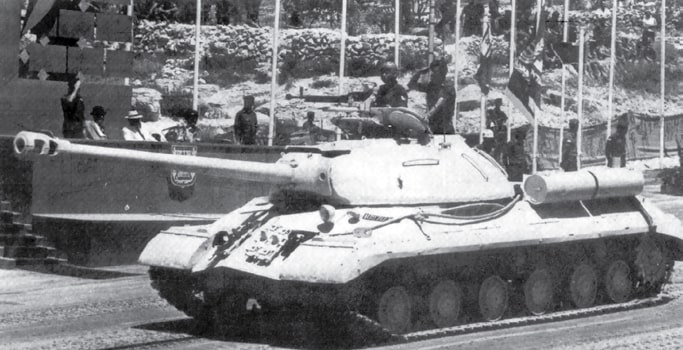 IS-3M parade IDF, 1967 g. Israelis love to show these heavy tanks in its military parades
IS-3M parade IDF, 1967 g. Israelis love to show these heavy tanks in its military parades
Therefore, at the end of the second modernization of the IS-3 was conducted 50s, after which the tank was designated IS-3M. The objective of this upgrade was the tightening of the tank to the level of combat vehicles of the period and the maximum possible unification of its units and units with more modern tanks (including with are already in mass production of T-54).
 IS-3M. Artist: Aaron Sheps
IS-3M. Artist: Aaron Sheps
combat application
Although the original shape of the hull and turret IS-3 long tank builders took over the minds of the world (in the west some impact IS-3 was felt in the form of housing and the tower of the American M-48 tank, German «Leopard 1" and the French AMX-30), his military career can not be called very successful.
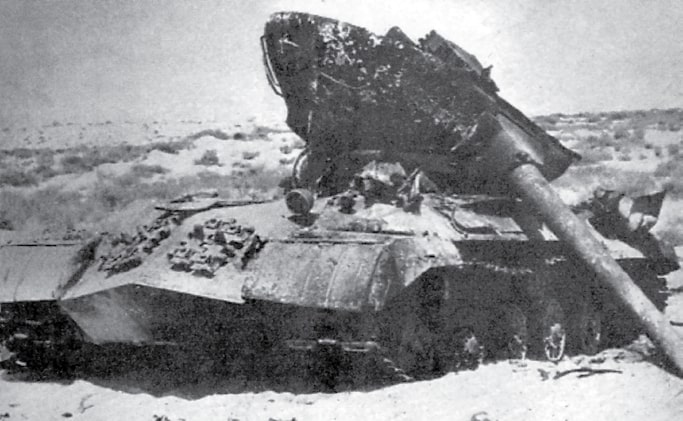 Egyptian IS-3, after a fight with a company of Lieutenant Ein-Gil in the southern section of the fortified Rafahskogo intersection
Egyptian IS-3, after a fight with a company of Lieutenant Ein-Gil in the southern section of the fortified Rafahskogo intersection
Despite the memories of some veterans (So, Lieutenant-General IS. Lykov in his book "In the hour of danger," talks about concrete examples of application of EC-3 to the 49th Guards tank regiment breakthrough in Germany, a A.A. Vishnyakov in the book "The tank on a pedestal" - their participation in the Battle of Berlin), in the fighting in the final stages of fighting in Europe, and even more so in the battle for Berlin, IS-3 did not participate (on 24 May 29 built IS-3 tanks were still in CHKZ).
Untrue and information about, EC-3 were tested as part of the Far Eastern group of troops during the fighting with the Kwantung Army in August-September 1945 of the year, as part of a tank regiment of the 1st Far Eastern Front. Although some sources mention, that the Far East was sent to a regiment (21 a car), armed with IS-3 tanks, and for their maintenance Kirov factory sent with this regiment special team headed by engineer EI. Roschin (He was still in the first tests of heavy tanks KV and T-100 in the Karelian Isthmus during the Finnish War).
In his memoirs Roshchina can read: « … to the area of combat operations IS-3 tanks were transported by rail to the port Posiet, and then transported to a transport vessel Far, tanks went further under its own power». However, historical data do not confirm, according to the documents nor the IS-2, nor even IS-3 did not participate in combat operations in the Far East. There was fighting only one 48-th separate heavy tank regiment, armed which had 21 heavy tank KV.
But although some fighting during the Second World War IS-3 did not have, but his first outing on the "stage" was very impressive. On Friday 7 September 1945 in Berlin held a grand military parade to commemorate the end of World War II. The parade of troops Soviet occupation troops involved, USA, Britain and France. On the podium of honor placed: Chief of Soviet occupation troops Marshal GK. Zhukov, commander of the US 3rd Army General George C.. Patton, British General Robertson and French General Marie P. Kyenig. According cleared of rubble and given in the relative order of Charlottenburg highway to the highest ranks of the infantry troops first marched, and after a short break on the highway out of armored column. The first were thirty-two American light tank M24 and sixteen armored M8. Then came the French tanks, armored personnel carriers and armored cars. British armored forces were twenty-four tank "Comet" and thirty armored vehicles.
Again came a little pause, which soon broke the oncoming roar of powerful engines. Rounding out hits heavy Soviet tanks completely unknown type of allies, armed with large-caliber guns. Moving three in a row, tanks approached the podium. The column consisted of fifty-two cars - combined unit, created on the basis of 71-th Guards regiment of heavy tanks, 2-Guards Tank Army.
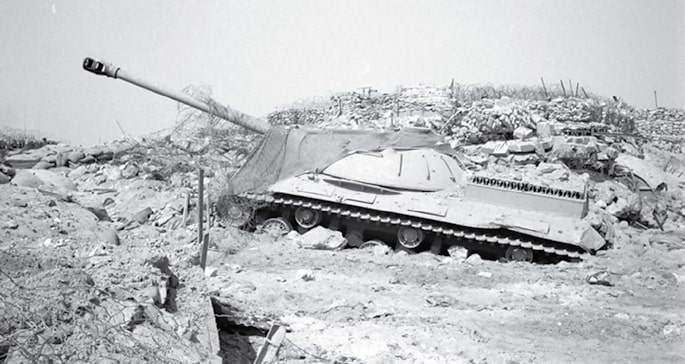 IS-3, transformed into a firing point on the line of Israeli fortifications along the Suez Canal ("Line Bar-Leva»). On this machine, remove the engine, and in its place is situated additional Ammo
IS-3, transformed into a firing point on the line of Israeli fortifications along the Suez Canal ("Line Bar-Leva»). On this machine, remove the engine, and in its place is situated additional Ammo
Witness the parade British Brigadier General Frank Hawley later wrote in his memoirs: "As for the armor, the Allies limited demonstration of light tanks and armored cars. A Russian surpassed all - deafening grinding tracks, Concrete highway past the tribune proceeded hundred (to heighten the effect of the general doubled the number of tanks) latest giant tanks of the "Joseph Stalin". Compared with all Russian tanks on Unter den Linden as if shrunk. keeping system, tanks drove past, vent their powerful guns Leaky Heaven ".
After the parade Zhukov sent Stalin a report, in which, in particular, the following was stated:
«… Our tanks IS-3 made an indelible impression on foreigners. The tanks have been in neat rows and performed well ".
IN USSR, in their homeland, IS-3 were first demonstrated only a year later - at the parade in Moscow, conducted 7 November 1946 of the year.
Unlike its predecessor, the IS-2, which was used in the armies of many countries in the world, IS-3 tank was delivered abroad in very limited quantities.
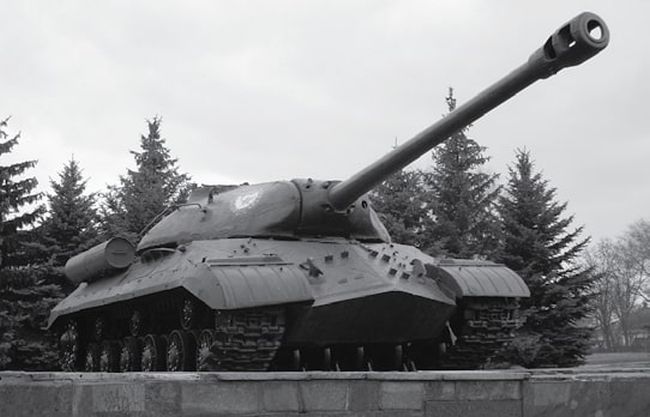 IS-3, mounted in g. Krivoy Rog.
IS-3, mounted in g. Krivoy Rog.
Shortly after World War II, a few tanks got Czechoslovakia and Poland. Poland passed two cars (serial numbers and 703.604A81 703.605A58) to review the construction and training instructors. probably, anticipated, that the Polish Army will take him in his arms. The first of these two tanks hit the officer's school tank troops in Poznan. For many years the machine has been used for the training of cadets, and then won a place in the museum of the Graduate School of the officers of armored forces.
The second copy was sent to the military technical academy in Warsaw, where it was used as a teaching tool in the training of military engineers. In the fifties,, when Defense Minister Marshal of Poland was K. Rokossovsky, the IS-3 participated in military parades; the car was usually headed by armored columns. In the early 70-ies of the tank was taken to the landfill in Orzysz. There, partially dismantled, He almost twenty years has been used as an observation post. In the early 90s the car was taken back to Warsaw. Now the tank is in the collection of heavy weapons Museum of the Polish Army in Fort Chernyakuvskom.
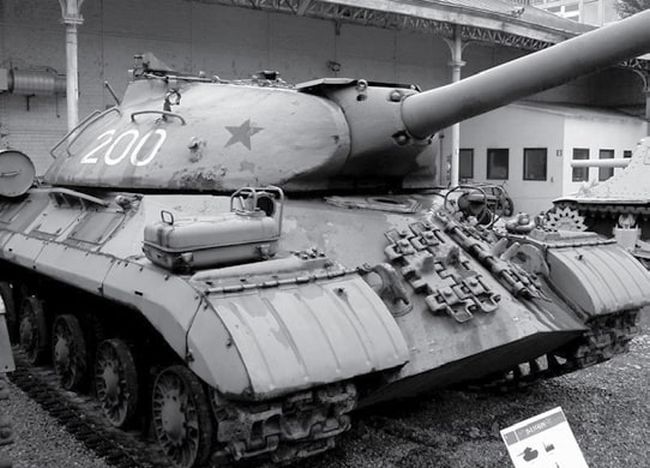 IS-3M in the museum exhibition in Belgium
IS-3M in the museum exhibition in Belgium
The fate of the tank, sent to Czechoslovakia, It is known in less detail. The first time the tank participated in military parades, and now this exhibit Army Museum in Prague.
A significantly greater number of IS-3 tanks were sent to North Korea (apparently, after the end of the Korean War). In the 60s there was one regiment of heavy tanks in the two North Korean tank divisions.
To take part in combat operations IS-3 first came to Hungary 1956 year. After the withdrawal of Soviet troops from Austria, at 1955 year, in Hungary Special Corps of Soviet troops was organized, which included the 2nd and the 17th Guards Mechanized Division. among tanks, are in service parts Special Corps, and there were heavy IS-3. Special corps was intended to cover, together with units of the Hungarian People's Army of the border with Austria and to provide critical communications in the event of extension of the Soviet troops from the territory of the USSR. The most tragic pages of combat use IS-3 became the Hungarian events 1956 of the year. At the disposal of the rebels were about 100 tanks.
A major role in street fighting in Budapest played 33rd Kherson Red Banner Order of Suvorov twice Guards Mechanized Division, to which was supported by the 100th Tank Regiment (31-Panzer), armed with IS-3 tanks. Early morning 4 the main force in November 2nd and 33th Guards mechanized divisions to go broke in Budapest and the day captured the bridges across the Danube, airfield Budapesh, capturing with almost all the tanks rebels, 15 guns and 22 Aircraft.
Tanks cannon fire and rammed done the passages in the barricades, built on the streets of Budapest, punching way for the infantry and paratroopers. The scale of the battles is evidenced by the fact, that the assault on the resistance unit in the cinema "Corwin", which involved part of 33th Guards Mechanized Division 5 November, It began after the artillery attack, which was attended by 170 guns and mortars. On three sides of several dozen tanks shot surviving emplacements. Only in the evening, Soviet troops captured the quarter.
About fighting gravity indicates that, that only 33 Guards Mechanized Division lost 14 Tanks and self-propelled guns, 9 armored vehicles, 13 guns, 4 installing BM-13, 31 car and 5 motorcycles. What part of the tanks were lost IS-3 - it is not clear, but judging from the known footage and photos, at least a few of these cars were destroyed or burned in the streets of the capital of Hungary.
In just a few months before the events in Hungary, in June 1956 , the foreign press and observers reported a large military parade in Cairo, held in honor of the "Independence Day" - 23 June. Among other armored vehicles, obtained from the Soviet Union, Egyptians demonstrated and EC-3 tanks. Then Prime Minister of Egypt, Colonel Gamal Abdel Nasser, trying to strengthen the Egyptian army, Let us first for help to the United States. However, the ocean to the request of the head of Egypt reacted with indifference, therefore, Nasser decided to conclude a treaty with the Soviet Union.
27 September 1955 an agreement was signed between the USSR and Egypt on the supply of Soviet arms to equip the Egyptian army. By July 1956 The Soviet Union has almost fulfilled its obligations. Also T-34-85, self-propelled units SU 100 and BTR-152, Egyptians received and the party IS-3 tanks (commonly reported 25 tanks of this type).
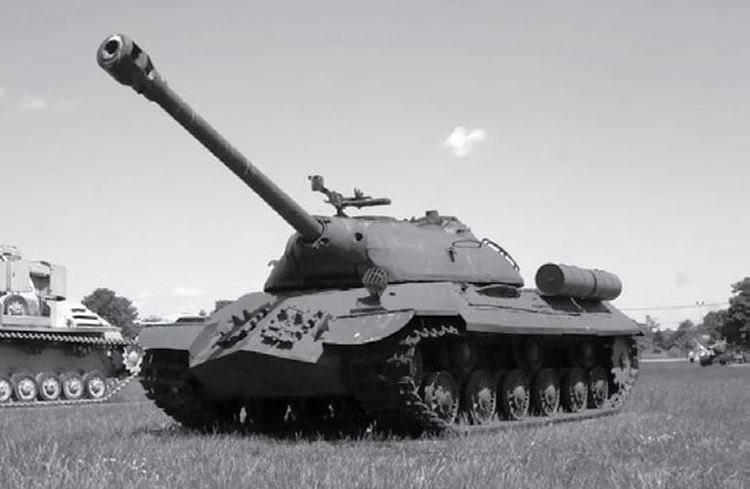 IS-3 in Aberdeen, USA
IS-3 in Aberdeen, USA
After, Nasser announced 26 July 1956 , on the nationalization of the Suez Canal and entered in the channel area of the Egyptian troops - in the Middle East smell of gunpowder, a 29 October, the Israeli army embarked on a "Cadet" plan whose goal was the capture of the Sinai Peninsula and access to the Suez Canal. 5 November combined Anglo-French troops carried out air-sea landing operation "Musketeer", as a result of which was captured by the Port Said and to march into the territory of Egypt along the Suez Canal. When planning this operation, Western command considered with the presence of EC-3 Egyptians tanks. Therefore, in the shock group was part of the 6th Tank Regiment, equipped with tanks «Centurion», since the power of the infantry anti-tank 17-pounder gun was found to be insufficient. But this measure is not allowed to be sure of the outcome of the operation, because the 20-pound gun Centurion was also ineffective against the IS-3.
In this situation, the British tank crews underwent additional training, which was led by Colonel E.F. Offord of the Experimental Department in Bovington. During the course of additional British artillery fire worked out new ways to manage and studied the most vulnerable point of Egyptian tanks.
But, Fortunately for the British and French, their fears were not realized - in a combat zone IS-3 did not have tanks. probably, Egyptians held in reserve Isa, Besides, perhaps, Tank crews were still insufficiently trained.
Deliveries of IS-3 tanks continued in 1962-1967 years. Total Egypt has received more than 100 Machines of this type. Along with the tanks arrived in Egypt and Soviet instructors, and Egyptian officers were trained in special courses, organized by the Academy of armored forces in Moscow.
The Egyptian army IS-3 tanks were considered powerful machines support the troops and were park several tank battalions (by 20-30 machines). The battalions were attached to infantry and motorized divisions, as well as some armored brigades, forming part of armored divisions. So, IS-3 battalion was composed of the 7th Infantry Division, takes up defensive positions at the turn of Khan Yunis - Rafah. Yet 60 IS-3 had a total of 125 Tank Brigade, a position which is near El Kuntilly.
5 June 1967 , the Israelites began fighting in the Sinai Peninsula, gone down in history as the "Six Day War". A major role in land battles played armored and mechanized forces of Israel, which is based on the American tanks M48 "Patton III». Initially, these tanks were armed with a weapon of 90-mm caliber, but some machines Israelis managed to re-equip the 105-mm guns. Besides, Israel possessed modernized British tanks "Centurion" (the so-called tanks "Ben Gurion", also with the caliber of guns 105 mm) and quite outdated American tanks M4 "Sherman" (local modification of the M51 "Isherman" was rearmed French 105mm instrument). Israel's army was well equipped to handle mobile warfare, while the Egyptians favored a static defense.
Israeli tank crews were regarded as a threat, posed by heavy Egyptian tanks, armed with powerful guns and protected by thick armor. They knew, that only 1965-67 years was delivered to Egypt 25 heavy IS-3M tanks. However, in a maneuver IS-3 battle lost more modern tanks Israelis. Affected the low rate of fire and outdated sighting system forties, which allows you to aim fire only during stops, while Israeli M48A2 stood optical rangefinder sight and two-plane stabilizer. Poorly suited for use in hot climates were IS-3 engines. But most importantly - training and combat training of the Israeli tank was far higher, than Egyptian. I suffered from low general education level of the bulk of the personnel, hampers the development of military equipment. It was low, and the moral and morale of soldiers, do not exhibit sufficient stability and persistence.
After the end of the "Six Day War" Israelis announced, that they were able to knock out and grab 820 enemy tanks, including 73 heavy IS-3M. Israeli losses amounted to 120 tanks. Most of the captured IS-3M has been delivered to the repair shop and brought into operation. Israeli sources reported, that Isamu also replaced the engines, setting on the machine instead of standard diesel engines similar to the B-54, removed from the broken T-54 / T-55. In this changed and the roof of the engine compartment.
Trophy tanks often participated in the military parade on the occasion of national holidays of Israel. At the end of the 60s, at the suggestion of the then Chief of Staff of the Israeli army, General Haim Bar-Lev, captured machines dug along the Suez Canal, creating here a fortified line of defense. There were dug in 33 tanka, but to 1973 year in readiness was only 16 machines. These fortifications were called "Bar Lev Line". During the "Yom Kippur War" in 1973 was dug in tanks did not have any significant effect on the course of events, and were soon completely lost, since the area came back into the hands of the Egyptians. During the "Yom Kippur War" Egyptians have at least one regiment of heavy tanks IS-3M, but his participation in the data is not fighting.
In the 80s the Egyptian army was officially removed from service tanks IS-3 type, and the surviving machines were decommissioned and scrapped. Several cars bought tank museums around the world. So, IS-3M are available in the museum at the Aberdeen Proving Ground in the US, in a museum in Belgium. As for the JS-3 in its purest form, then in all likelihood it was kept only in the Polish city of Poznan, at the Museum of the Higher Officers' School of armored forces.
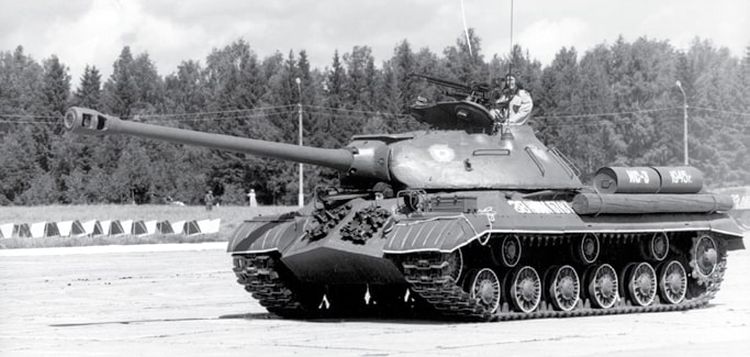 IS-3M, supported in the running condition at one of the festivals in Moscow Kubinka
IS-3M, supported in the running condition at one of the festivals in Moscow Kubinka
During an exacerbation of Soviet-Chinese relations in the late 60s and especially after an incident on the island in Taman 1969 was outdated by the time IS-3M tanks with other "old" - T-44, IS-4 and T. P. They were sent to the Far East, "to strengthen the protection of the Soviet-Chinese border".
Part of the IS-3M were left on the course and were used to guard the border in a mode of combat duty. These cars were in the pits of tank parks with full ammunition and tucked fuel tanks and combat anxiety had the task to take a pre-prepared positions. Other tanks were used for the construction of fortified settlements on the Soviet-Chinese border from the Far East and Trans-Baikal to Central Asia - they were buried in the ground at the tower, turning into a kind of bunkers. It is usually with them to dismantle all mechanisms are not necessary for the conduct of the course - the engine, gearbox etc..
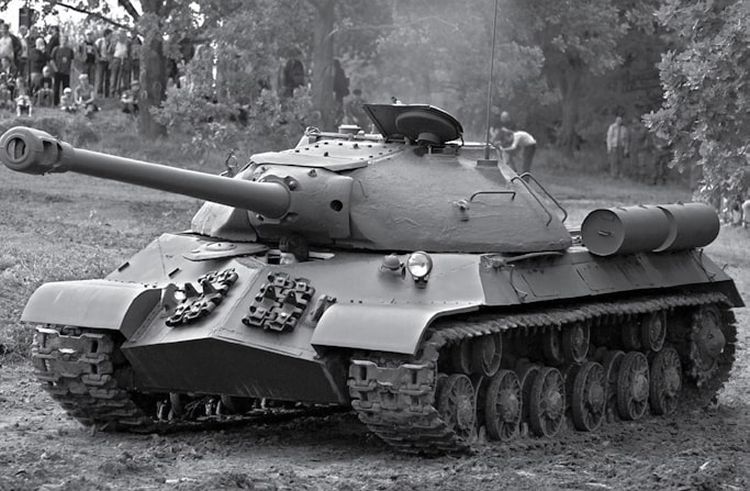 Restored to the running state of IS-3, of War Museum in Lisani, Czech Republic
Restored to the running state of IS-3, of War Museum in Lisani, Czech Republic
The CIS currently there are numerous IS-3M tanks, established as monuments or preserved as museum exhibits. They can be seen in Kiev, Minsk, Chelyabinsk, Novorossiysk, Pavlodar, Belgorod and many other places. There are a few "on the fly" IS-3, one of which belongs to the museum's collection in Moscow Kubinka, the other in the military museum in the Czech Republic in Lisani.
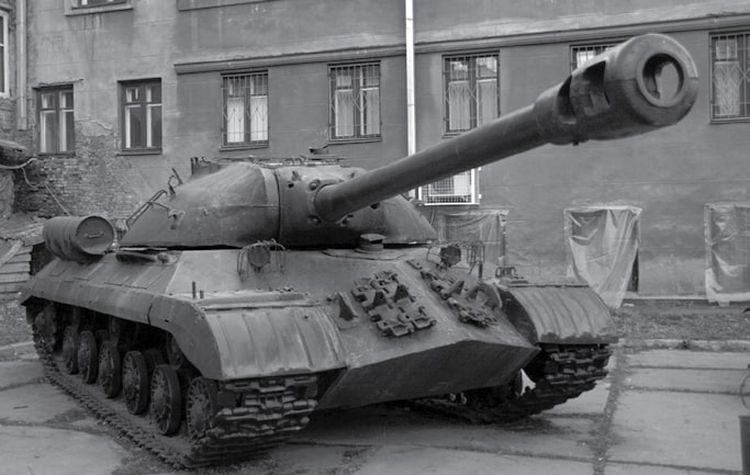 IS-3M in Ekaterinburg museum, 2007 g.
IS-3M in Ekaterinburg museum, 2007 g.
In conclusion, EC-3 in their tactical and technical characteristics, undoubtedly, superior to its predecessor and grandparent - Soviet heavy tank IS-2. As I mentioned above, very flattering assessment of EC-3 and earned abroad. Here is another quote - West German expert Dr. Von Senger und Etterlina, which can hardly be suspected of bias:
«rational design of the bow hull and turret praiseworthy. Besides, This tank has a very low height. On 1956 year IS-3 tank retains the blend of martial qualities of "the best for heavy machinery.
Despite this, significant design flaws significantly reduced the combat capabilities of this machine. Figuratively speaking, at birth IS-3 has received a "birth trauma", from which the consequences of his and were not able to completely cure, despite holding two large-scale modernization programs.







